Skip to comments.
Biblical site tied to Ark of the Covenant unearthed at convent in central Israel [long]
Times of Israel ^
| 10 January 2019
| Amanda Borschel-Dan
Posted on 01/14/2019 5:17:02 AM PST by SJackson
Excavation uncovers a unique, monumental structure previously unknown in the region. Was it a shrine — or the site of David’s triumphant parade of the legendary ark?
Amanda Borschel-Dan is The Times of Israel's Jewish World and Archaeology editor.
A massive 8th century BCE man-made platform discovered at a Catholic convent in central Israel may have served as an ancient shrine to the Ark of the Covenant, said leading Tel Aviv University archaeologist Israel Finkelstein. Unearthed at Kiriath-Jearim, the shrine gives potential new insight into the political machinations of the sibling kingdoms of Judah and Israel.
Remains of the monumental elevated podium have been unearthed on a Judean hilltop long associated with the location of biblical Kiriath-Jearim. According to the Hebrew Bible, the spot was the 20-year home of the legendary Ark of the Covenant until taken by King David and paraded to Jerusalem.
The joint expedition by Tel Aviv University and the College de France is not on the trail of the elusive ark, however. Indeed Finkelstein, the dig’s co-director, does not believe the Ark of the Covenant existed.
Get The Times of Israel's Daily Edition by email and never miss our top stories Free Sign Up
Rather, it is in search of physical evidence from almost three millennia ago of the geopolitical situation in the border town, located between the two monotheistic kingdoms.
The large elevated platform, Finkelstein believes, was constructed by the northern kingdom as a shrine to the biblical story of the ark.
“The excavations at Kiriath-Jearim shed light on the strength of Israel (the Northern Kingdom) in the early 8th century, including, possibly, its domination of Judah,” Finkelstein told The Times of Israel. “They also illuminate an important theme in the Bible – the Ark and its history.”
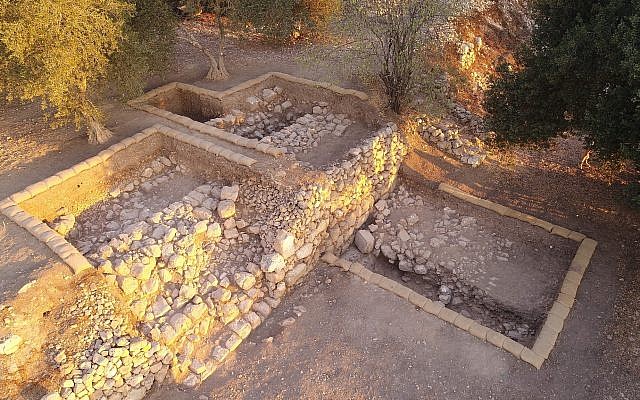
An aerial view of Area C, a broad terrace on the lower eastern slope, at the end of the 2017 season, looking north. (Shmunis Family Excavations at Kiriath-Jearim)
Alongside some 50 student volunteers, in the summer of 2017 Finkelstein and co-directors Thomas Römer and Christophe Nicolle broke ground on the Shmunis Family Excavations at Kiriath-Jearim on the private grounds of a Catholic nunnery situated near the central Israeli-Arab village of Abu Ghosh.
According to Römer, an internationally known expert on the Hebrew Bible, the biblical stories surrounding the Ark of the Covenant served pragmatic political purposes. “The kernel of the original narrative was to legitimate Kiriath-Jearim as the new sanctuary of the shrine after the destruction or the abandonment of Shilo,” wrote Römer in an email to The Times of Israel this week.
In 1995-96, there was a small salvage excavation headed by Gabriel Barkay ahead of convent construction on the hill. There were additional surveys conducted there by Amir Feldstein in the 1980s, and Boaz Zissu and Chris McKinny in 2013.
“The previous studies – both the salvage dig and the surveys – drew a similar picture of the settlement history of the site, but no find of note has been discovered,” said Finkelstein.
That is, until the recent game-changing discovery of a massive man-made platform. The elevated rectangular podium, report the archaeologists, can be reconstructed to have been circa 150-110 m in size and covering an area of some 1.65 hectares. Created with typical Iron Age walls, 3-m wide and which still stand 2-m high, it is oriented exactly north-south and east-west.
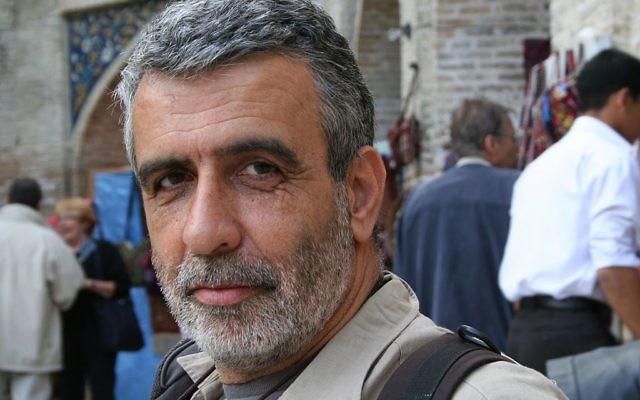
Israeli archaeologist, Prof. Israel Finkelstein. (Argonauter, CC-BY-SA, via wikipedia)
It is an oddity in the kingdom of Judah, which, according to the Bible, once ruled Kiriath-Jearim.
Finkelstein and his co-directors believe the platform may have been a shrine built by the Northern Kingdom in commemoration of the Ark of the Covenant story, a compelling narrative that speaks to a tradition shared with the kingdom of Judah.
Could it also be an indication of the power struggle in the region during the 8th century BCE?
“A Northern affiliation of the site in the early 8th century is not that surprising, because of the domination of Israel over Judah at that time and as the Ark Narrative in the Books of Samuel seems to be of Northern origin,” said Finkelstein.
According to the team’s preliminary excavation report, “The goal was probably to legitimate Kiriath-Jearim as the ‘new’ shrine of the Ark. Accordingly, in the case of a North Kingdom affiliation, the elevated platform was built in order to accommodate an Israelite administration compound, including a temple, aimed at dominating the vassal kingdom of Judah.”
A hill with a view
Modern Kiryat Ye’arim is bordered by Abu Ghosh, an Israeli-Arab village celebrated for its plethora of specialty humus shops. Today it is also known as Telz-Stone, after the European roots of the ultra-Orthodox community residing there. Located less than a kilometer north of the Tel Aviv–Jerusalem Highway, the hilltop upon which the convent sits is strategically placed.
According to the recent preliminary report “Excavations at Kiriath-Jearim near Jerusalem, 2017,” which was published in 2018 in the annual peer-reviewed Semitica journal, the hilltop “commands a sweeping view of large stretches of the coastal plain and the Mediterranean coast (from Jaffa to Ashkelon) in the west, the western neighborhoods of modern Jerusalem in the east and the Judean Mountains in the southeast.”
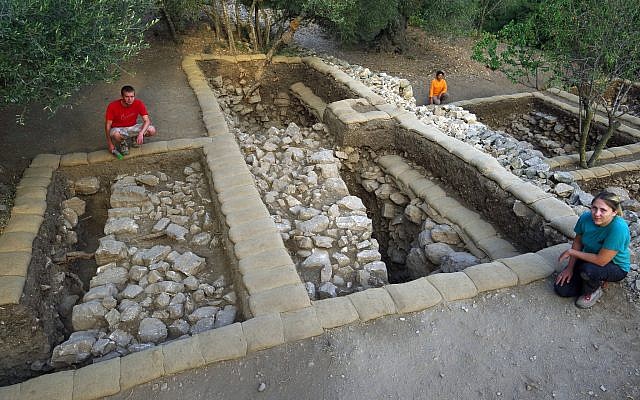
In the upper terrace at Kiriath-Jearim, a massive wall was unearthed some 15 cm below topsoil. The well-preserved wall is circa 3 m broad and preserved to 2.15 m on its outer face. (Shmunis Family Excavations at Kiriath-Jearim)
Today the hill is carved up by terraced slopes dotted with olive trees, which provide an evergreen relief to the stone construction of the old 1906 convent, slightly later hostel, and the 1924 Church of Our Lady of the Ark of the Covenant.
The archaeological dig is unusually located on private church property under the protection of the French government, a situation stemming from a 1949 agreement with the fledgling State of Israel. Today the site serves as the Convent of the Ark of the Covenant, which covers the hill’s summit, and is occupied by the Sisters of St. Joseph of the Apparition.
There is no possibility of excavating the summit, an important strategic location in the ancient world. “First, we cannot disturb the peace of the convent; second, the summit is probably eroded; third, it was built over by a large monastery in the Byzantine period,” Finkelstein enumerated.
Even with the church construction, it is somewhat surprising that such an important biblical site has not yet been excavated. “Perhaps this has to do with the fact that it is a private property; certainly, one can understand the wish of the nuns not to be disturbed. Now, with the College de France involved, it was easier to get the green light from the convent,” said Finkelstein.
From the initial planning stages, the team has worked closely with the nuns in finding appropriate spots between the compound’s structures. “The interaction with the nuns is cordial and friendly,” said Finkelstein.
At the dig’s conclusion, the sisters will be faced with the decision of whether to open up the site to tourists. The nuns, he said, have been very accommodating, but as the discoveries mount, are increasingly concerned about their peace of mind.
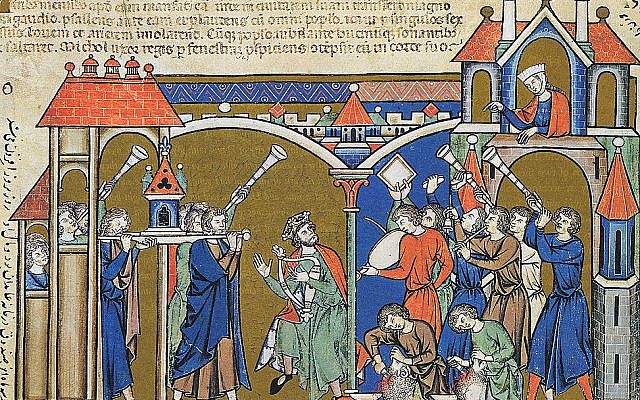
Illustration from the 13th century Morgan Bible of David bringing the Ark into Jerusalem (2 Samuel 6). (public domain via wikipedia)
Rightly so: analysis of the artifacts unearthed so far leave little doubt that this is the biblical site of Kiriath-Jearim. The name is mention in several books of the Hebrew Bible, including a detailed story in I Chronicles 13, 5-8, in which King David jubilantly transports the ark to Jerusalem.
“And David went up, and all of Israel, to Baalah, that is, to Kiriath-jearim, which belonged to Judah, to bring up from thence the ark of God… David and all the Israelites played, celebrating with all their might before God, with songs and with harps, lyres, timbrels, cymbals and trumpets,” reads the account.
Other historical texts, including the ancient name directory, the “Onomasticon” by Eusebius of Caesarea, a 3rd-4th century Church historian and counselor of Constantine the Great, also indicate this spot is the biblical site.
Likewise, the archaeologists note that the Arabic name of the site, Deir el-ʿAzar, “seems to be a corruption of ‘The Monastery of Eleazar,’ probably the name of the Byzantine monastery, which commemorated the name of the priest who was in charge of the Ark when it was kept at Kiriathjearim (1 Sam 7: 1).”
Technology to plumb ancient depths
To locate the most likely dig spot between the compound’s buildings, the team consulted World War I Bavarian aerial survey images as well as modern aerial footage, and created a hi-tech orthophoto using a drone and Digital Elevation Model.
“The high-tech methods helped us to visualize the ancient topography and locate the lines of the main terraces. So these methods helped in dictating the fields of excavations, which indeed proved to be highly successful,” said Finkelstein.
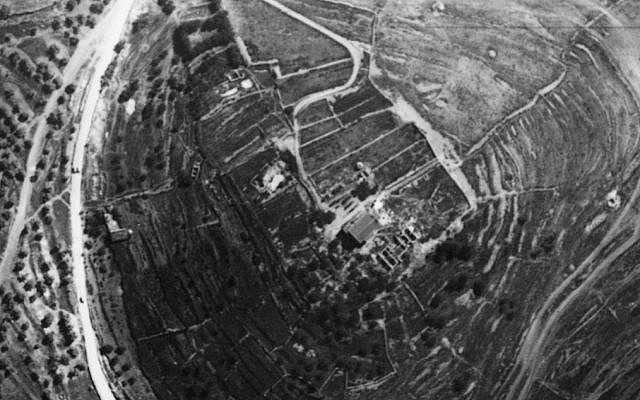
Aerial view of the site, taken by the Bavarian air force in 1918, looking north. Note large western and eastern terraces. The modern building is the old house of the convent; to its north are the foundations of the northern sector of the hostel (the church was not built yet). (Courtesy Shmunis Family Excavations at Kiriath-Jearim)
While the team has unearthed countless artifacts, but the discovery of the Iron Age platform’s walls was clearly its biggest success.
“Indeed, the existence of these walls, which supported an elevated Iron Age platform, is the most important find so far,” said Finkelstein.
Due to the 3-D visualizations of the mound, when evidence of the platform was finally discovered, said Finkelstein, “I was surprised and not. Surprised, because this type of elevated podiums is known mainly in the Northern Kingdom (Israel) and here we are on their very southern boundary. Not surprised, because from looking at the topography and the orthophoto I suspected the existence of an elevated platform on the summit.”
The platform, a monumental architectural feat, compels the question of who built it? Which people would have had the ability to construct it in the era suggested by the pottery dating and the walls’ appearance? In an additional wrinkle, there is the paucity of culturally typifying finds. “There is nothing in the material culture, except for the podium, to hint at the north,” said Finkelstein.
Stymied, the scientists commissioned hi-tech Optical Stimulated Luminescence (OSL) dating, which suggested the time period of Iron IIB, or circa 8th century BCE
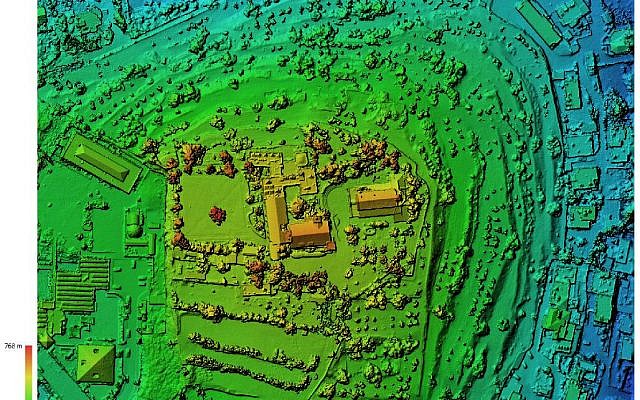
Digital Elevation Model of the mound of Kiriath-Jearim. (Shmunis Family Excavations at Kiriath-Jearim)
“Bearing in mind the monumentality of this endeavor, and the fact that no elevated platforms of this type are known in Judah, there are two possibilities within the Iron IIB: an Assyrian venture after 720 BCE, or a North Israelite construction before 732 BCE, in fact before the beginning of decline of the kingdom in 747 BCE,” write the archaeologists in their report.
According to the archaeologists, other similar platforms were well-known in the Northern Kingdom during the suggested window of time, including in the capital Samaria. Typically they consisted of massive support walls with land fills which create an artificial hill.
The pottery debris close to the wall dates to the Iron IIB (900-700 BCE), said the archaeologists and the timing of the construction could also point to the northern kingdom: “An elevated platform at Kiriath-Jearim could have been built by Israel following the subjugation of Judah by Joash,” as noted in 2 Kings 14: 11-13. “Accordingly, the days of Jeroboam II (788-747 BCE), in the middle of the 8th century, well-fit both the OSL and the ceramic data,” write the authors.
During the course of the excavation, and in comparing the findings from the smaller earlier digs, the archaeologists discerned continued, intensified settlement in the following Iron IIC period (700-586 BCE), as well as reconstruction of the platform. Further reconstruction occurred in the late Hellenistic periods. “The latter may be associated with the fortification efforts undertaken by the Seleucid General Bacchides,” suggest the scholars.
One platform to rule them all
The second excavation season will commence in August 2019 with an equally large team of professionals and volunteers. “This time too we plan to put the main emphasis on the big walls which support the elevated platform,” said Finkelstein.
Finkelstein, for whom the Ark of the Covenant is legend, not fact, said there is no physical evidence at Kiriath-Jearim of the ark having historically resided at the site — nor does he expect to find any. But why the legend was propagated is of interest to the team.
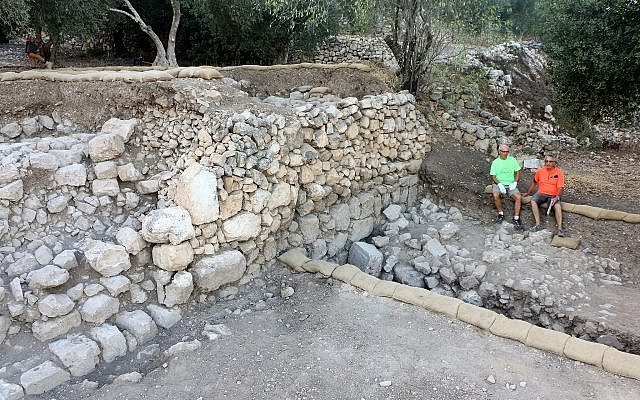
At Kiriath-Jearim, excavation of a set of terraces along the southeastern slope of the mound. (Shmunis Family Excavations at Kiriath-Jearim)
“Why the Northern Ark Narrative was introduced into the Bible is a very good question. It is one of a series of Northern traditions which found their way to the south. Perhaps the idea was to explain how the ark found its way to Jerusalem,” he said.
Finkelstein’s excavation co-director Römer weighed in, “The Ark narrative was introduced into the Bible because in its present form it legitimates Jerusalem as the only ‘official’ sanctuary of Yhwh, since according to the Biblical narrative, David transferred the Ark there from Kiriath-Jearim.
“Later redactors made of the stay of the ark in Kiriath-Jearim a short period [in 1 Samuel 7:2: it is written that the ark was housed for 20 years] in order to suggest that the ark arrived quite quickly in Jerusalem. But historically that happened much later, probably under King Josiah,” wrote Römer.
The large platform at Kiriath-Jearim would have been multi-functional — both as a shrine and a ruling center, said the excavators.
“A platform can of course contain a shrine,” said Römer, “and the fact that according to 1 Samuel 7:1 the ark did not return to Shiloh from where it was captured but came to Kiriath-Jearim clearly indicates the cultic function of the place.”
Finkelstein suggested that the story of the Ark “served the ideology of the Northern Kingdom in the time of Jeroboam II, as well as the actual territorial needs which stemmed from the domination over Judah.”
“I suspect that this shrine of the ark was part of a United Israel (ruled from Samaria) ideology – the forerunner of the later Judahite United Monarchy concept,” said Finkelstein.
TOPICS: Israel; News/Current Events
KEYWORDS: aaronitepriesthood; arkofthecovenant; faithandphilosophy; godsgravesglyphs; israel; israelfinkelstein; kiriathjearim; shmunisfamily
1
posted on
01/14/2019 5:17:02 AM PST
by
SJackson
To: dennisw; Cachelot; Nix 2; veronica; Catspaw; knighthawk; Alouette; Optimist; weikel; Lent; GregB; ..
Middle East and terrorism, occasional political and Jewish issues Ping List. High Volume If you’d like to be on or off, please FR mail me.
..................
2
posted on
01/14/2019 5:17:32 AM PST
by
SJackson
(The Constitution only gives people the right to pursue happiness. You have to catch it yourself)
To: SunkenCiv
3
posted on
01/14/2019 5:18:15 AM PST
by
SJackson
(The Constitution only gives people the right to pursue happiness. You have to catch it yourself)
To: SJackson
It is unbelievably rich that Israel Finkelstein is involved with this. He’s spent his whole career trying to debunk the accuracy of Biblical stories.
4
posted on
01/14/2019 5:24:55 AM PST
by
jjotto
(Next week, BOOM!, for sure!)
To: SJackson
something has always been there
what is speculation based on speculation
5
posted on
01/14/2019 5:30:27 AM PST
by
bert
( (KE. N.P. N.C. +12) Princess Gray Beaver, for President?)
To: jjotto
Indeed Finkelstein, the dig’s co-director, does not believe the Ark of the Covenant existed. A search for something you think isn't there? The faker is him.
Back in reality, if various chroniclers--among people with a tradition of accurate historiography that keeps being confirmed by archaeology-- have been writing about something for millennia . . . it existed.
To: SJackson
Can we hire this team to search for the Front Door of the Branch Davidians in Waco Texas??
7
posted on
01/14/2019 5:58:59 AM PST
by
eyeamok
To: jjotto
Eilat Mazar, please pick up the white courtesy phone....
To: jjotto
...as do many modern archaeologists. It’s amusing, given the fact that archaeologists also use the Bible as a definitive source for archaeological leads and invariably end up proving one or more biblical stories previously believed to be myths.
9
posted on
01/14/2019 6:19:45 AM PST
by
ManHunter
(You can run, but you'll only die tired... Army snipers: Reach out and touch someone)
To: SJackson
The joint expedition by Tel Aviv University and the College de France is not on the trail of the elusive ark, however. Indeed Finkelstein, the dig’s co-director, does not believe the Ark of the Covenant existed. Rather, it is in search of physical evidence from almost three millennia ago of the geopolitical situation in the border town, located between the two monotheistic kingdoms.
Zzzzzzzz.
To: SJackson
11
posted on
01/14/2019 6:51:20 AM PST
by
faucetman
(Just the facts, ma'am, Just the facts)
To: jjotto
Finkelstein
I agree, in his view the entire Bible is nothing more than myth.
Even here he is unwilling to concede that the Ark was an actual thing.
He is the epitome of modern scholastic arrogance.
12
posted on
01/14/2019 7:37:41 AM PST
by
Pietro
To: SJackson
13
posted on
01/14/2019 7:48:00 AM PST
by
seawolf101
(Member LES DEPLORABLES)
To: PlateOfShrimp
...William Albright and William Dever too...
14
posted on
01/14/2019 7:54:01 AM PST
by
Jan_Sobieski
(Sanctification)
To: StayAt HomeMother; Ernest_at_the_Beach; 1ofmanyfree; 21twelve; 24Karet; 2ndDivisionVet; 31R1O; ...
Thanks SJackson. Because it's from Finkelstein, grain of salt.

15
posted on
01/14/2019 8:48:01 AM PST
by
SunkenCiv
(and btw -- https://www.gofundme.com/for-rotator-cuff-repair-surgery)
To: Pietro
Shouldn’t we wait for Harrison Ford to weigh in on this? He’s the expert on the Ark of the Covenant, after all.
To: SJackson
Totally off topic but I was intrigued by the references to the “Bavarian Air Force” in the article. While there were Bavarian squadrons in the German Air Force of WWI I’m not aware that they formed a separate service designated as Bavarian. Or is this just an inaccuracy in the article?
17
posted on
01/14/2019 9:20:26 AM PST
by
jalisco555
("In a Time of Universal Deceit Telling the Truth Is a Revolutionary Act" - George Orwell)
To: jjotto; SJackson; SunkenCiv; BTerclinger; Phinneous
I love these stories not just for the archeaological discoveries, but for the insights that appear in the source texts. (The articles direct me to read up on or refresh my memory of the original events.)
In this case, the account involves that fatal "parade accident." So as I was reading along in verse 8...
1 Chron 13
7. And they carried the ark of God in a new cart from the house of Abinadab; and Uzza and Ahio drove the cart:
8. And David and all Israel played before God with all their might [oz], and with singing, and with harps, and with lyres, and with tambourines, and with cymbals, and with trumpets:
9. And when they came to the threshing floor of Kidon, Uzza put forth his hand to hold the ark; for the oxen stumbled:
10. And the anger of the Lord was kindled against Uzza, and he struck him, because he put his hand to the ark; and there he died before God:
11. And David was upset, because the Lord had broken forth upon Uzza; and that place is called Perez-Uzza to this day:
12. And David was afraid of God that day, saying, How shall I bring the ark of God home to me:
And David and all Israel played before God with all their might...
Shouldn't that be "heart"? It would explain the problem, and answer David's question in verse 12.
might: oz [עז]
Uzza: [עזא]
Falls right along with a name being a minor prophecy, and also what Rabbi Mendel Kessin says about the Messianic Light, the revelation of all knowledge. That is, when it's revealed why everything happened (for good or ill), it'll all make perfect sense and we will thank God for it.
The cart incident "redirected" the Ark to Obed-Edom's house, and the narrative then continues into chapter 14, with David building a house.
14. And the ark of God remained with the family of Obed-Edom in his house three months; And the Lord blessed the house of Obed-Edom, and everything that he had:
Which reminds me in case anyone is interested... "everything that he had" is kol asher lo [כל אשר לו]. To say "all that I have is "kol asher li" [כל אשר לי], which permutes to all Israel [כל ישראל].
And David and all Israel played before God with all their... hearts:
"Hooray!" (Huzzah!)
Huzza (an exclamation famously shouted when the USS Constitution got her nickname Old Ironsides):
The origin of the word in its various forms is not clear, but it may have been influenced by war cries from various languages: the Oxford English Dictionary (OED) suggests Danish, Swedish, Dutch, Russian and Prussian words that may have played a part.
>>>
The OED notes that in the 17th and 18th centuries, it was identified as a sailor's cheer or salute, and suggests that it was possibly related to words like heeze and hissa, which are cognates of hoist.
https://en.wikipedia.org/wiki/Huzzah
"How shall I bring the ark of God home to me."
*Hazeh.*
That's really going to be some parade. The Cheruvim on the Ark are as "a man facing his brother" (Ex 25:20).
All in the timing, okay and the math too:
the house of Obed-Edom the Gittite = 951 =
Sefer Torah
Shema Israel
Israeli (f.)
Holy One of Israel [e.g. in Psa 71:22]
Esav haRasha
the best garments of her eldest son Esau (Gen 27:15)
Every detail is important. The captain's name was Hull. Isaac Hull. God really knows how to bring history to life and seed it into memory.
It's all orchestrated.
18
posted on
01/14/2019 10:08:11 AM PST
by
Ezekiel
(All who mourn(ed!) the destruction of America merit the celebration of her rebirth.)
To: jalisco555
After the proclamation of the German Empire, some kingdoms, including Bavaria and Prussia retained their identity and, in peacetime, separate militaries. They all fell with the end of WWI. This from Wiki about fighter squadrons:
"Following the era of the KEK units through the summer of 1916, Jagdstaffeln (hunting squadrons), established by the reorganization that started by the late summer of 1916 were fielded by four kingdoms of the German Empire. Individually - each of these units was often known by the abbreviation "Jasta". The Kingdom of Prussia was predominant, with a fighter force eventually comprising 67 squadrons. The Kingdom of Bavaria formed ten of these units, the Kingdom of Saxony formed seven and the Kingdom of Württemberg four."
I would assume this photo was taken by a German air force plane supporting Ottoman/German operations against the British?
To: Pietro
It sounds like the wall goes around an area of about 4 acres. So that is about 1,700 feet of wall, 9 feet wide and 6 feet tall.
That is a lot of boulders to bring in to the site. I have no idea how long it would have taken to build - but it was obviously a large effort.
I can just see the priest (according to this Finkelstein) giving his speech after the people have slaved over this structure.
“What a wonderful structure you have build. What a great way to remember the story of the mythical ark! Okay - now get to work on building stuff we can actually use.”
I know that the ark has specific measurements, and the holy of holies housing it in the temple did too. I wonder if the tent housing it prior to the temple being built also had special dimensions? Although it would obviously be smaller than 4 acres.
20
posted on
01/14/2019 3:12:56 PM PST
by
21twelve
(!)
Disclaimer:
Opinions posted on Free Republic are those of the individual
posters and do not necessarily represent the opinion of Free Republic or its
management. All materials posted herein are protected by copyright law and the
exemption for fair use of copyrighted works.
FreeRepublic.com is powered by software copyright 2000-2008 John Robinson
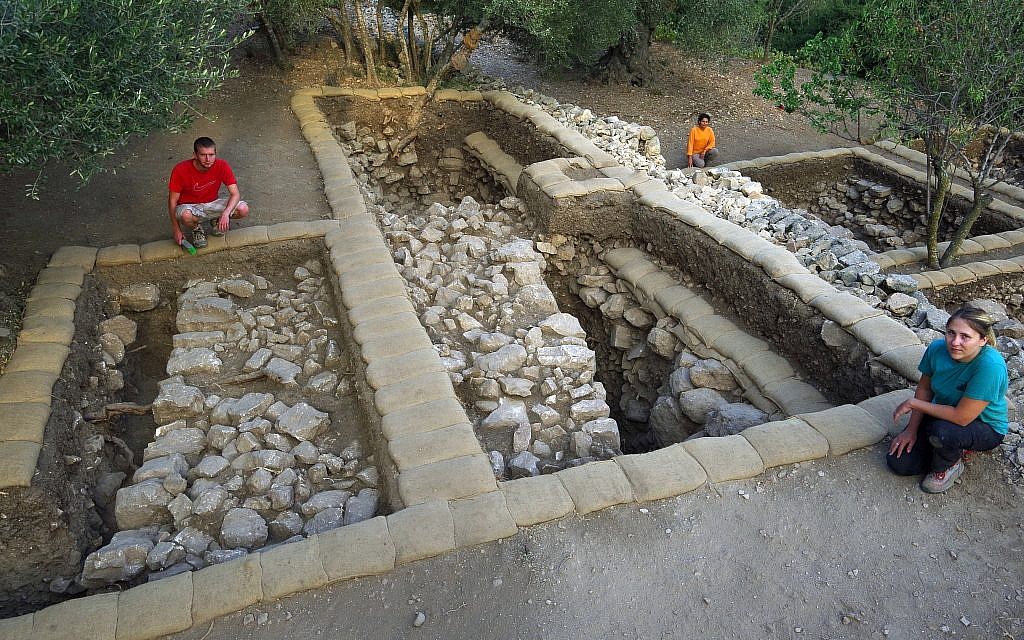 In the upper terrace at Kiriath-jearim, a massive wall was unearthed some 15 cm below topsoil. The well-preserved wall is circa 3 m broad and preserved to 2.15 m on its outer face. (Shmunis Family Excavations at Kiriath-jearim)
In the upper terrace at Kiriath-jearim, a massive wall was unearthed some 15 cm below topsoil. The well-preserved wall is circa 3 m broad and preserved to 2.15 m on its outer face. (Shmunis Family Excavations at Kiriath-jearim)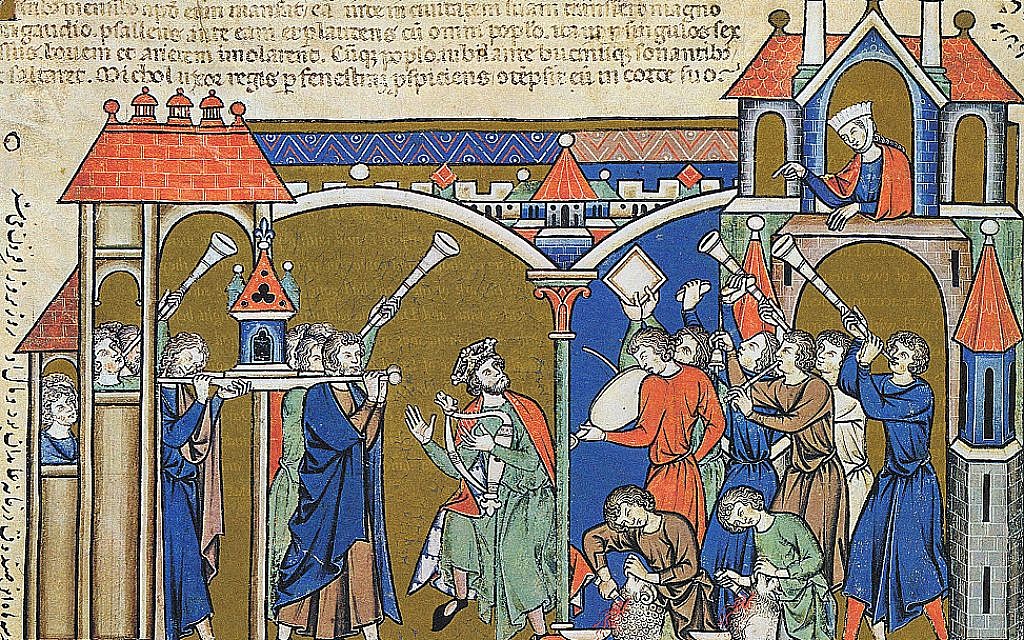 Illustration from the 13th century Morgan Bible of David bringing the Ark into Jerusalem (2 Samuel 6). (public domain via wikipedia)
Illustration from the 13th century Morgan Bible of David bringing the Ark into Jerusalem (2 Samuel 6). (public domain via wikipedia)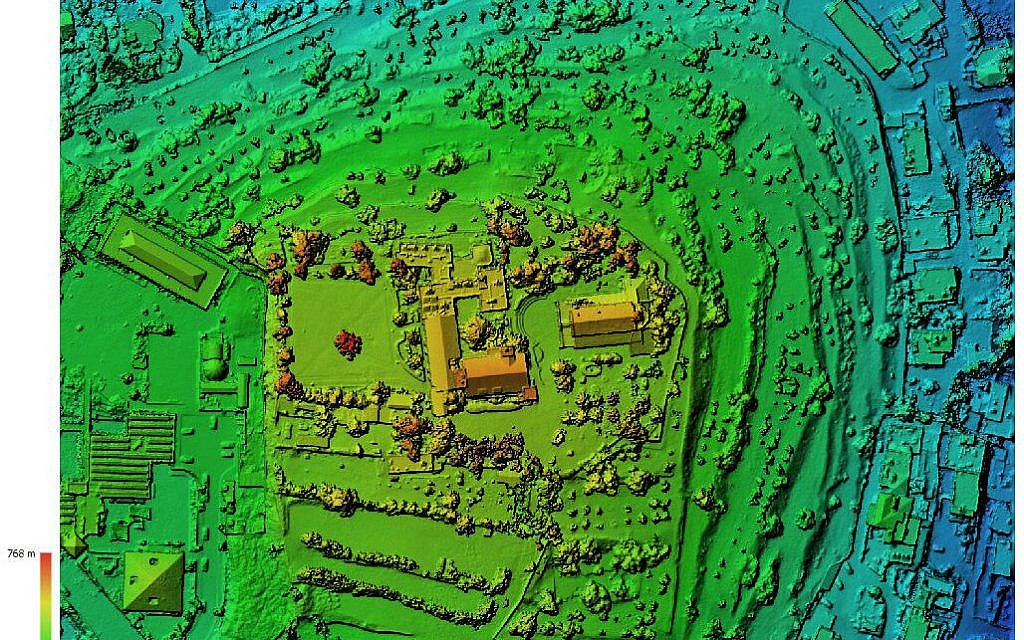 Digital Elevation Model of the mound of Kiriath-jearim. (Shmunis Family Excavations at Kiriath-jearim)
Digital Elevation Model of the mound of Kiriath-jearim. (Shmunis Family Excavations at Kiriath-jearim)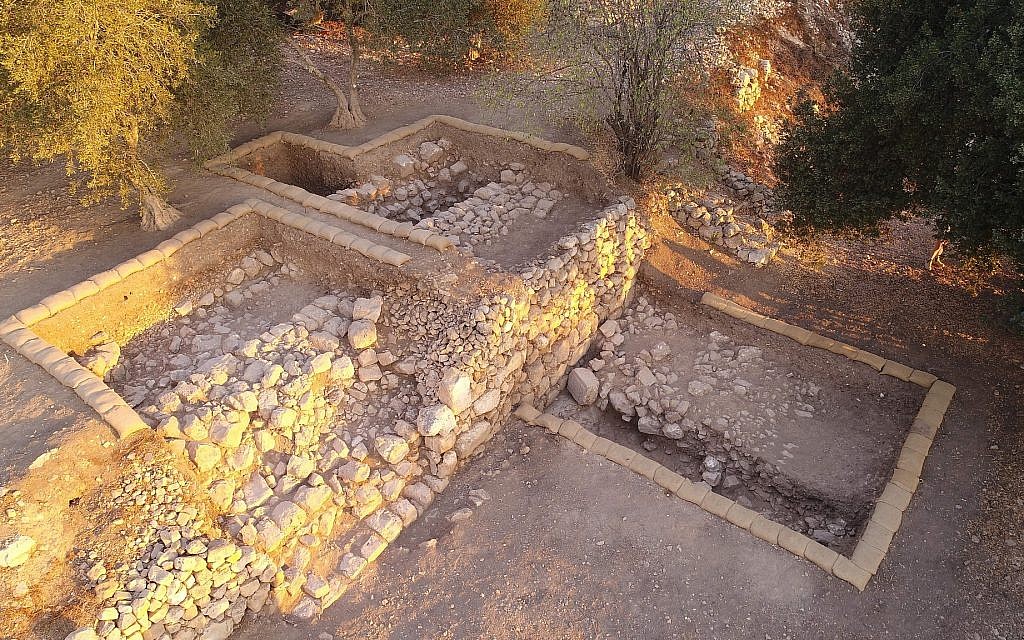 An aerial view of Area C, a broad terrace on the lower eastern slope, at the end of the 2017 season, looking north. (Shmunis Family Excavations at Kiriath-jearim)
An aerial view of Area C, a broad terrace on the lower eastern slope, at the end of the 2017 season, looking north. (Shmunis Family Excavations at Kiriath-jearim)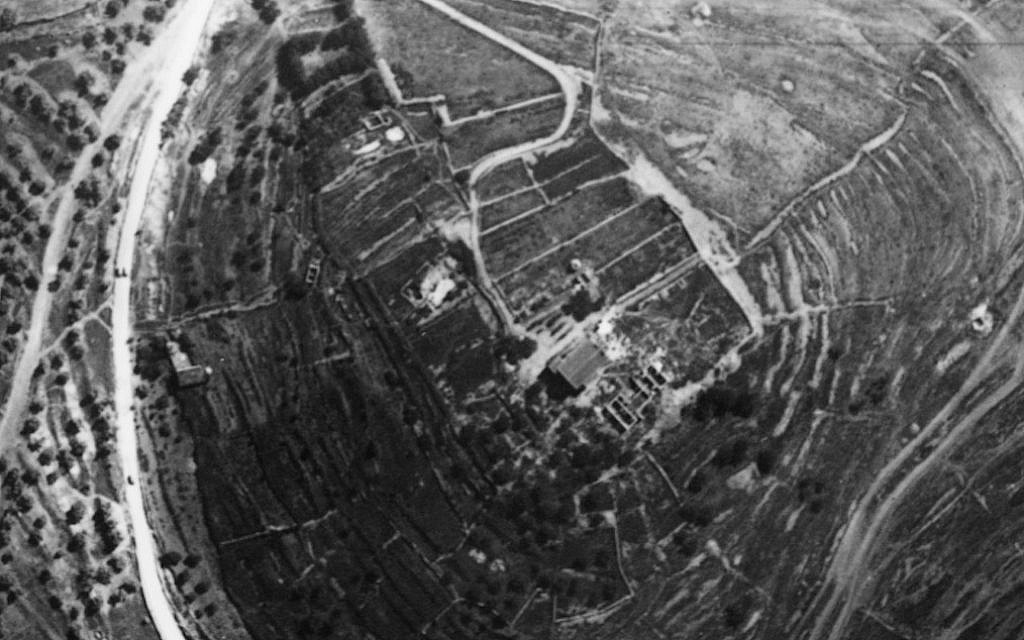 Aerial view of the site, taken by the Bavarian air force in 1918, looking north. Note large western and eastern terraces. The modern building is the old house of the convent; to its north are the foundations of the northern sector of the hostel (the church was not built yet). (Courtesy Shmunis Family Excavations at Kiriath-jearim)
Aerial view of the site, taken by the Bavarian air force in 1918, looking north. Note large western and eastern terraces. The modern building is the old house of the convent; to its north are the foundations of the northern sector of the hostel (the church was not built yet). (Courtesy Shmunis Family Excavations at Kiriath-jearim)






